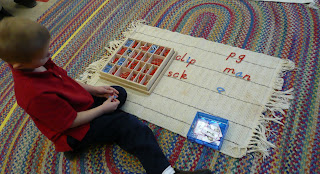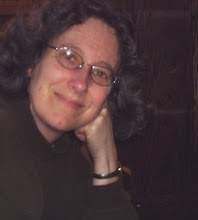
These girls are doing a "work" known as "Bottles and Tops." It consists of a collection of interesting little bottles shaped like animals. The children remove all the tops, mix them up, match the tops to the bottles, and put them back on; a very simple idea but a source of fascination to our youngest students. The activity develops small muscle coordination and strength of the hand, develops the sense of order, and provides an opportunity to do a complete cycle of work (choosing, setting up, completing, and restoring the materials).

This boy has made a creative design with the cubes of the famous Montessori "Pink Tower". Once a child can make the basic design, which in this case is a tower, he is invited to create a new design. We tell him that "a design is something that has order, in this case, ordered from the smallest to the largest. But the order can be arranged in many ways. Can you think of a new way to arrange these cubes?"...."Yes!"

 The girl in front is in her second year in the Children's House. She learned to write numbers last year and is now making a "Number Roll". On long sheets of grid paper, she writes each number in order, beginning with "1". One of our returning students has already reached 300!
The girl in front is in her second year in the Children's House. She learned to write numbers last year and is now making a "Number Roll". On long sheets of grid paper, she writes each number in order, beginning with "1". One of our returning students has already reached 300!The girl next to her is drawing creatively on blank paper, which is always available for student's use. Some children draw everyday as part of their daily routine.
 This child is working with the "Geometry Cabinet", a series of drawers containing shapes arranged by category. This one is the rectangle drawer. He is matching the various rectangles to a series of cards with the same shape either filled in, or outlined with a thin line or a thick line. This work develops visual perception of size and shape, develops the sense of order, and prepares the mind for further work in geometry. The child is also introduced to the names of the various geometric shapes.
This child is working with the "Geometry Cabinet", a series of drawers containing shapes arranged by category. This one is the rectangle drawer. He is matching the various rectangles to a series of cards with the same shape either filled in, or outlined with a thin line or a thick line. This work develops visual perception of size and shape, develops the sense of order, and prepares the mind for further work in geometry. The child is also introduced to the names of the various geometric shapes.
This 5 year old, second year student is working with the "Movable Alphabet". He has pictures of objects that are spelled phonetically, and is finding the letters that represent the various sounds heard in each word. This exercise is a pre-cursor to writing on paper and helps the child focus on the sounds he hears in words without having to commit to writing them on paper, a more difficult task.

We conclude with the ever-popular "Yarn Bookmark". It is the first real sewing project. Once a child can complete a lacing card, he is ready for the bookmark. It reinforces order and refinement of control in the small muscles of the hand.
We want to clarify that not every child in the room is ready for every work in the room. The ages of the children span a 3 year cycle. Every child is at a unique place in his or her development and each child is able to work at his or her own pace in the Montessori room.












































